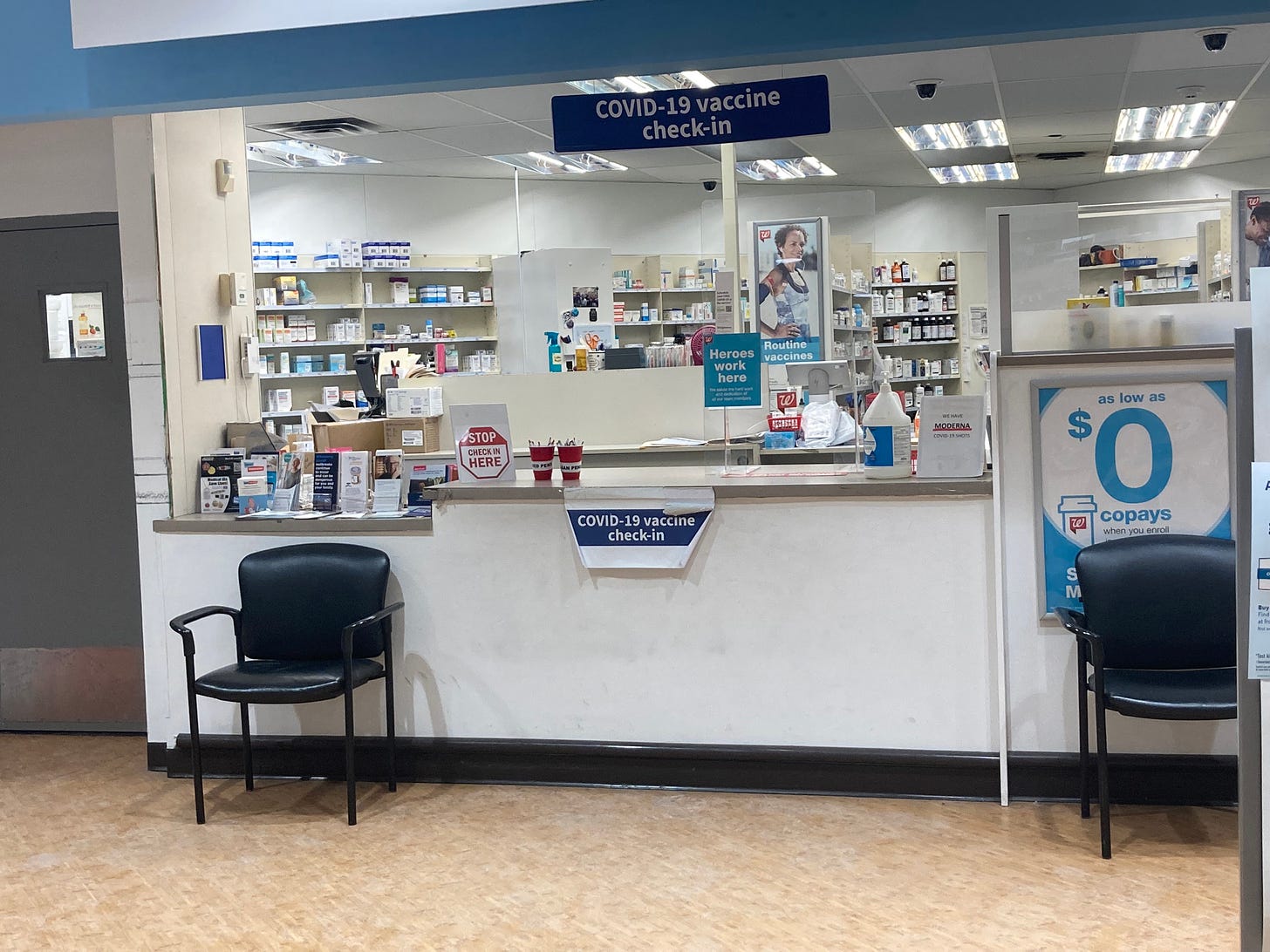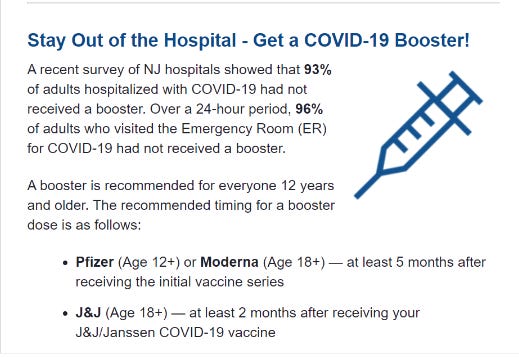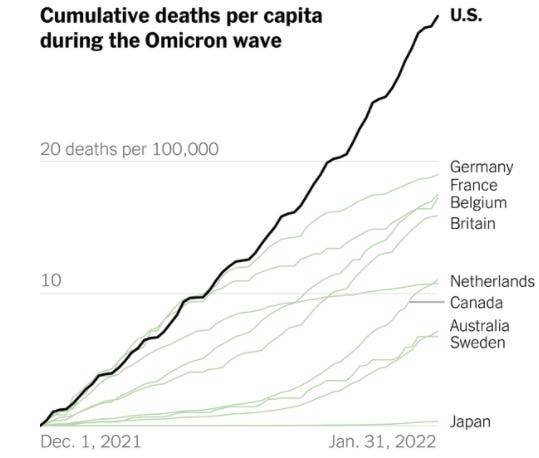The Rise of Omicron is the Fall of Vaccines
News Flash: The Vaccinated Are Now Three-Quarters of Hospital Admissions
This article is part of a publishing collaboration between RESCUE and Trial Site News. The reporting by Mary Beth Pfeiffer will be simultaneously published in both outlets. Please subscribe to RESCUE and Trial Site News for incisive pandemic reporting.

Unless one sells vaccines for a living, the overall numbers for the covid-19 variant Omicron will seem wildly encouraging.
Take a California study of 53,000 Omicron and 17,000 Delta cases from November 30, 2021, to January 1, 2022. In every way, Omicron patients did far better—a quarter the hospitalizations of Delta, miniscule admissions to ICU, no ventilation whatever, and a death rate of less than one-tenth of one percent.
The study, by researchers at UC-Berkeley and Kaiser Permanente, suggests, as do others, that Omicron may be the death knell of the pandemic. But, buried deep within its piles of data, it also calls into question the utility of the vaccines themselves.
Beyond showing that the vaccines faltered as Omicron overtook Delta in December, the study lays bare what until now was a heretical assertion.
The share of unvaccinated people hospitalized for Omicron infection was a mere 24 percent—43 of 182 hospitalized patients—compared to 69 percent for Delta.
Put the other way around, the vaccinated have morphed into about three-quarters of hospital admissions for the now-dominant Omicron.
These figures belie the rock-solid mainstream narrative that hospitals are filled with the unvaccinated. Clearly, the “pandemic of the unvaccinated”—always open to question—is no more.
“This is a huge change,” said Juan Chamie, a covid data expert who verified my conclusion from the data. “It is clearly contradicting the ‘99-percent unvaccinated in hospital’ narrative.”
Dr. Mobeen Syed, a YouTube medical educator who favors vaccination of high-risk groups, agreed. The public health message on the hospitalized unvaccinated, he said, was “not up-to-date and transparent enough,” relying on data early in the pandemic when fewer were vaccinated and the variant was different.
“They want to scare,” he told me. “They should have the courage to look at the data and say, ‘Hey guys, the risk (with Omicron) is reducing. Become happy, become more comfortable.’”
While the concept of hospitals packed with the unvaccinated has long been deceptive—as it was in a recent Los Angeles Times article—Omicron clearly and decisively has tipped the balance, the California data shows.
But this is happening elsewhere, too.
Alberta, Canada, has seen a sea change in hospitalized patients. Before Omicron, unvaccinated patients averaged 70 percent of hospitalizations. They are now 29.9 percent, according to government figures. Across Canada, 31 percent of hospital admissions from early December to mid-January were among the unvaccinated, an investigation by a British news site called The Expose found. And in Scotland, the share of unvaccinated admitted to hospitals was 22 percent in late December, dropping to 17 percent in mid-January, according to government figures.
Three realities have emerged about Omicron. Vaccines are faltering badly. The unvaccinated—though still at higher risk than the vaccinated—are doing much better. And Omicron illness, in the vast majority of cases, is a mild upper respiratory disease like other common coronaviruses, begging a question: Is a vaccine even needed for most people?

‘A New Epidemic’
On February 1, The Telegraph dubbed Denmark “The land where covid is now no worse than a cold.” That’s when it became the first nation to declare the pandemic over, lifting all restrictions even as Omicron cases still surged.
“This is a new epidemic situation,” wrote the nation’s health minister, Magnus Heunicke, in a letter to Parliament, “in which a high and increasing infection does not to the same extent as previously translate into hospitalizations.”
Consider what covid-19 was just a few months ago compared to what it is now, according to figures from the California study:
In real terms, there was just one death in 52,967 Omicron cases compared to 14 fatalities in the smaller group of 16,982 Delta patients—a rate that is eight times higher. Omicron is “associated with substantially reduced risk of severe clinical endpoints and shorter durations of hospital stay,” the paper concluded.
Dr. Been, as he is known, devoted three recent lectures to what he called the “good news” about Omicron, especially for the young and unvaccinated. “If someone is unvaccinated, I would say, ‘your risk has reduced,’” he told me. “You’re six times less prone to being hospitalized with this.”
In view of this, Dr. Been sees little need for vaccines and boosters for the vast majority under Omicron.
Yes, he says, the unvaccinated still have a statistically greater chance of infection than the vaccinated—but with a virus that imparts essential natural immunity and wreaks far less havoc than previous covid iterations.
“This was for me interesting to see that lower, younger ages, even unvaccinated, are actually at zero (mortality risk),” he told viewers in one lecture. “So I can’t understand why would it be important to go to them and say, ‘Make sure that you are vaccinated.’”
This is especially true in light of how vaccines work, and don’t, against a new-age variant for which they were not designed: Omicron.
Vaccines Unravel
Vaccines are the focus of this article because they are, unfortunately, the single-minded focus of U.S. and first-world covid policy. Any discussion of how the vaccines perform—and don’t—needs a twin disclaimer: Early treatment, with ivermectin and hydroxychloroquine for example, could have controlled the scourge of covid-19, saving many thousands of lives. As well, a targeted vaccine program, for the old and health-challenged, would have led to fewer people suffering from what the government calls “adverse events” from the vaccine—events that it has done little to seriously investigate.
Since the vaccine rollout a year ago, public health officials have pivoted on their plan to end covid by vaccination. Two shots and a booster later, we are told that the jabs’ highest calling is to spare the infected from hospitalization and serious illness.

But new research is rapidly undermining the vaccine’s rationale. Consider this:
In Ontario, Canada, vaccine efficacy plummeted within two months of second doses, from 89 percent against Delta to 36 percent against Omicron. Two doses “provided no protection after ≥180 days,” that study of 16,000 Omicron cases found.
The California study shows vaccines flagging in every way. Under Delta, half of people who tested positive were unvaccinated; under Omicron, they were a quarter. Even double- and triple-jabbed patients did worse when the new variant arrived. Two-dose patients were 39 percent of Delta cases; they rose to 53 percent of Omicron. Three-dose patients were 4.6 percent of Delta and 13.4 percent of Omicron, though these figures should be read with some caution because of the small number and general poor health of the boostered population.
In the United Kingdom, patients given two doses of Pfizer or Moderna vaccines had about 10 percent protection by twenty weeks; the Astra Zeneca vaccine’s efficacy virtually disappeared. Boosters suffered the same fate, dropping to 45 to 50 percent within ten weeks. “In all periods,” a government report said, “effectiveness was lower for Omicron compared to Delta.”
Even Pfizer CEO Albert Bourla owned up about Omicron on January 10. “Two doses of the vaccine offers very limited protection, if any,” he said, “Three doses with a booster offer reasonable protection.”
Dr. Been is one of millions of Americans urged to get boosted, receiving a text message in California like the one I got in New York. Noting the shots were available for ages twelve and up, the health department told me, “Get yours today!”
I declined. He was still considering it when he got covid. “My body has just proved I can become infected, and I can recover,” he said.
While Dr. Been stresses that boosters are helpful for at-risk people—like those suffering from cancer, HIV, cardiovascular illness, diabetes, and renal disease—he and others see little role for a sustained series.
“Trying to boost our way out of Omicron is the immune equivalent of heroin addiction,” Dr. David Wiseman, a PhD scientist and experimental pharmacology expert, told me. “The idea is that you have less and less benefit for more and more chance of harm.”
“The whole point about the Omicron wave, and why it’s such a good thing, is it’s giving us huge amounts of natural immunity,” Dr. John Campbell, a retired UK nursing educator and YouTube podcaster told his viewers recently. “We can’t keep vaccinating ourselves every few months.”

Bait and Switch
Having tried everything else, the New Jersey Department of Health is now pitching boosters in a way that undermines the previous message that vaccines would keep people out of hospitals.
“A recent survey of NJ hospitals,” its new come-on states, “showed that 93% of adults hospitalized with COVID-19 had not received a booster.” But typical of such claims, the department’s media office declined requests for the data, referring me to a website “dashboard” that offered nothing on the unboosted hospitalized.
Instead, I was bombarded by vaccine messages. People with weakened immune systems may need four doses, I was informed; children five to eleven (seen arm-in-arm and smiling broadly) are eligible for the Pfizer vaccine.
This drumbeat of pro-vax messages aims to drive ever more jabs. A Washington Post opinion piece recently called for an end to mask mandates but remained steadfast on the need to vaccinate. In upholding the government’s nursery-school-to-nursing-home vaccine program, however, the article pointed to statistics with little relevance to the overall population, noting that unvaccinated people sixty-five and up “are 52 times more likely to be hospitalized.”
Indeed, covid has hit the unvaccinated elderly hard. Unvaccinated people eighty years and older died at a rate fifteen times higher, the Alberta data shows, than 80+ people who received boosters. (This data covered the last 120 days so is predominantly Delta-driven.) But covid generally is a Boomer disease, with three-quarters of deaths in people age sixty-five and over.
Why, then, when the United States death toll passed 900,000 on February 4, did President Biden implore, "Get your kids vaccinated.”
Did he know that Omicron poses a very low threat to children, with just five children under eighteen, among 7,856 cases, hospitalized in the California study? Figures like that are routinely called “rare” for vaccine reactions like myocarditis in adolescents.
Did he know that not a single Omicron death has been reported, regardless of vaccination status, in children in Switzerland or Chile, to name just two?
And while pediatric Omicron hospitalizations rose in the UK, a review “found those admitted were not severely unwell.” The Royal College of Paedatrics assured parents that the increase in respiratory infections “was usual for this time of year,” and very few “children and young people…needed intensive care.”
In the United States, by contrast, there is fear generated at every turn, rather than reassurance that Omicron is a good development—all in the service of vaccinating.

Elephant in the Room
Covid-19 deaths in the United State are 63 percent higher than nine other industrialized nations. “In recent months, the United States passed Britain and Belgium to have, among rich nations, the largest share of its population to have died from Covid over the entire pandemic,” according to a New York Times analysis.
If Omicron is such good news—and studies universally agree it is—why is mortality here so stubbornly high?
The answer is beyond the scope of this article but among the theories posited:
Some deaths are still occurring among patients infected with the more virulent Delta variant.
High rates of obesity and other conditions, along with poor access to healthcare for many Americans, drives up mortality.
The inclusion of people who died from covid along with those who incidentally tested positive for it inflates the death toll.
The almost universal use in American ICUs of the drug remdesivir, which is known to cause kidney and liver damage and has little efficacy, may lead to death by treatment rather than by covid. (That’s perhaps the most stunning theory but one for which I believe there is support.)
The lack of vaccination and boosters for many older, vulnerable people likely plays a role, as the Times article points out. But the vaccine explanation fails to see the bigger picture.
As the US approaches the 1 million mark in deaths, it is clear that the response to this pandemic has been tragically flawed. Public health officials have sown fear and earned distrust. They have failed to treat.
Because the power structure refuses to recognize Omicron for what it is—a way out through natural immunity—those mistakes continue.
Mary Beth Pfeiffer’s reporting and most recent book, LYME: The First Epidemic of Climate Change, led her to covid-19. Both diseases have been denied and mismanaged in a corrupt health care system. LYME was just released in paperback.






Great article mary.
Great post. But don’t you mean “the inclusion of deaths with incidental Covid” inflates the death toll? As opposed to countries that don’t attribute those deaths to Covid.